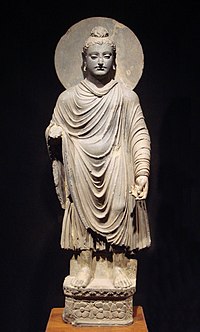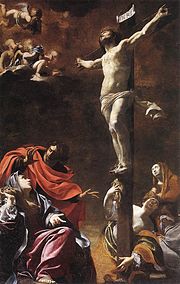
Eschatology concerns expectations of the end of the present age, human history, or the world itself. The end of the world or end times is predicted by several world religions, which teach that negative world events will reach a climax. Belief that the end of the world is imminent is known as apocalypticism, and over time has been held both by members of mainstream religions and by doomsday cults. In the context of mysticism, the term refers metaphorically to the end of ordinary reality and to reunion with the divine. Various religions treat eschatology as a future event prophesied in sacred texts or in folklore.
Universalism is the philosophical and theological concept that some ideas have universal application or applicability.

Comparative religion is the branch of the study of religions with the systematic comparison of the doctrines and practices, themes and impacts of the world's religions. In general the comparative study of religion yields a deeper understanding of the fundamental philosophical concerns of religion such as ethics, metaphysics and the nature and forms of salvation. It also considers and compares the origins and similarities shared between the various religions of the world. Studying such material facilitates a broadened and more sophisticated understanding of human beliefs and practices regarding the sacred, numinous, spiritual and divine.

Maitreya or Metteyya, also Maitreya Buddha or Metteyya Buddha, is regarded as the future Buddha of this world in Buddhist eschatology. As the 5th and final Buddha of the current kalpa, Maitreya's teachings will be aimed at reinstating the dharma, a vital concept in Hinduism, Buddhism, Sikhism and Jainism. In all branches of Buddhism, he is viewed as the direct successor of Gautama Buddha. In some Buddhist literature, such as the Amitabha Sutra and the Lotus Sutra, he is referred to as Ajita. Despite many religious figures and spiritual leaders claiming to be Maitreya throughout history, all Buddhists firmly agree that these were false claims, indicating that Maitreya, the Buddha of the Future, is yet to appear.
Christianity and other religions documents Christianity's relationship with other world religions, and the differences and similarities.
The religious perspectives on Jesus vary among world religions. Jesus' teachings and the retelling of his life story have significantly influenced the course of human history, and have directly or indirectly affected the lives of billions of people, even non-Christians. He is considered by many to be one of the most influential persons to have ever lived, finding a significant place in numerous cultural contexts.
Messianism is the belief in the advent of a messiah who acts as the savior of a group of people. Messianism originated as a Zoroastrianism religious belief and followed to Abrahamic religions, but other religions have messianism-related concepts. Religions with a messiah concept include Judaism (Mashiach), Christianity (Christ), Islam, Druze faith, Zoroastrianism (Saoshyant), Buddhism (Maitreya), Wotanism, Taoism, and Bábism.
Buddhist eschatology, like many facets of modern Buddhist practice and belief, came into existence during its development in China, and, through the blending of Buddhist cosmological understanding and Daoist eschatological views, created a complex canon of apocalyptic beliefs. These beliefs, although not entirely part of orthodox Buddhism, form an important collection of Chinese Buddhist traditions which bridge the gap between the monastic order and local beliefs of Imperial China.

Queen Māyā of Shakya was the birth mother of Gautama Buddha, the sage on whose teachings Buddhism was founded. She was sister of Mahāpajāpatī Gotamī, the first Buddhist nun ordained by the Buddha.
Generally speaking, Buddhism is a religion that does not include the belief in a monotheistic creator deity. As such, it has often been described as either (non-materialistic) atheism or as nontheism, though these descriptions have been challenged by other scholars, since some forms of Buddhism do posit different kinds of transcendent, unborn, and unconditioned ultimate realities.

Buddhism and Jainism are two Indian religions that developed in Magadha (Bihar) and continue to thrive in the modern age. Gautama Buddha and Mahavira are generally accepted as contemporaries. Jainism and Buddhism share many features, terminology and ethical principles, but emphasize them differently. Both are śramaṇa ascetic traditions that believe it is possible to attain liberation from the cycle of rebirths and deaths (samsara) through spiritual and ethical disciplines. They differ in some core doctrines such as those on asceticism, Middle Way versus Anekantavada, and self versus not-self.

There were links between Buddhism and the pre-Christian Mediterranean world, with Buddhist missionaries sent by Emperor Ashoka of India to Syria, Egypt and Greece from 250 BC. Significant differences between the two religions include monotheism in Christianity and Buddhism's orientation towards nontheism which runs counter to teachings about God in Christianity, and grace in Christianity against the rejection of interference with karma in Theravada Buddhism on.

The historic Buddha or Gautama Buddha, is considered the ninth avatar among the ten major avatars of the god Vishnu, according to the Vaishnava tradition of Hinduism.

Buddhism was known in the pre-Christian Greek world through the campaigns of Alexander the Great, and several prominent early Christian fathers, including Clement of Alexandria and St. Jerome, were aware of the Buddha, even mentioning him in their works. However, the majority of modern scholars who have studied both Buddhism and Christianity hold that there is no direct historical evidence of any influence by Buddhism on early Christianity. Scholars generally consider any such influence implausible given that first century Jews are highly unlikely to have been open to far eastern concepts that appeared opposed to some of their basic beliefs.
Gautama Buddha, the founder of Buddhism, is also venerated as a manifestation of God in Hinduism and the Baháʼí Faith. Some Hindu texts regard Buddha as an avatar of the god Vishnu, who came to Earth to delude beings away from the Vedic religion. Some Non-denominatonal and Quranist Muslims believe he was a prophet. He is also regarded as a prophet by the Ahmadiyyah.
Buddhologist Edward Conze (1966) has proposed that similarities existed between Buddhism and Gnosticism, a term deriving from the name Gnostics, which was given to a number of Christian sects. To the extent that Buddha taught the existence of evil inclinations that remain unconquered, or that require special spiritual knowledge to conquer, Buddhism has also qualified as Gnostic.
Lynn de Silva's theology began at an early stage in Lynn de Silva's ministry, when his interest in Buddhism and its culture began to increase. He believed that the credibility of Christianity depended on its ability to relate to Buddhism, which was the faith of the majority of the Sri Lankan population. His objective was to develop a richer appreciation of the similarities between Buddhism and Christianity, in particular, to communicate the Christian message in a manner that the Sri Lankan culture understood, and to construct a theology that is focused towards the Buddhist cultural environment. To this end, he used Buddhist concepts to communicate Christian beliefs in a language understood from the Buddhist context, and he aimed at extending Christian theology with Buddhist concepts in order to gain a more thorough understanding of Christianity. In his book The Problem of the Self in Buddhism and Christianity, de Silva states the following:
There is a growing body of opinion within Christianity that its theology is shop-soiled and needs drastic revision in order first, to re-root it in the basic biblical teaching, secondly, to bring it into harmony with new insights and modes of thought coming from other faiths, ideologies and modern science and thirdly, to relate it to social realities... What I have attempted is to help this process of transformation in Christian thinking. However, theological thinking in order to be meaningful and relevant must be contextual. The context of this book is Buddhism.
Secular Buddhism—sometimes also referred to as agnostic Buddhism, Buddhist agnosticism, ignostic Buddhism, atheistic Buddhism, pragmatic Buddhism, Buddhist atheism, or Buddhist secularism—is a broad term for a form of Buddhism based on humanist, skeptical, and agnostic values, valuing pragmatism and (often) naturalism, eschewing beliefs in the supernatural or paranormal. It can be described as the embrace of Buddhist rituals and philosophy for their secular benefits by people who are atheist or agnostic.
Since the 20th century, Buddhism and Judaism have become associated with one another due to the common religious overlap in Jewish Buddhists. According to the Ten Commandments and classical Jewish law (halacha), it is forbidden for any Jew to worship any deity other than the God of Israel – specifically by bowing, offering incense, sacrifices and/or poured libations. It is likewise forbidden to join or serve in another religion because doing so would render such an individual an apostate or an idol worshipper.

In Manichaeism, Siddartha Gautama is considered one of the four prophets of the faith, along with Zoroaster, Jesus and Mani. Mani believed that the teachings of Gautama Buddha, Zoroaster, and Jesus were incomplete, and that his revelations were for the entire world, calling his teachings the "Religion of Light".











